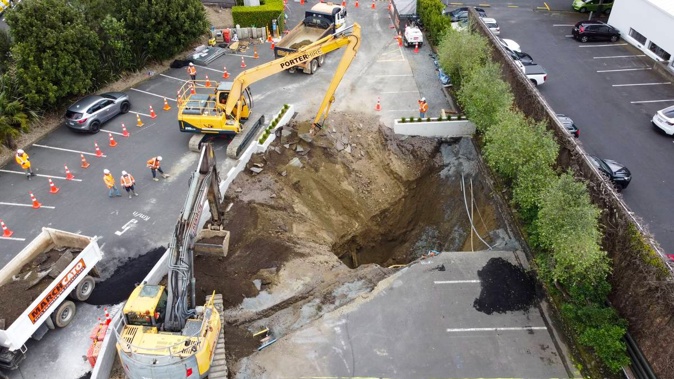
A culmination of seven key factors including weather events and deteriorating pipes caused the giant Parnell sinkhole and led to about eight million litres of wastewater pouring daily into Waitematā Harbour, a report has found.
Watercare has released its findings today into the cause of the massive sinkhole and sewer blockage in Parnell with the council organisation apologising profusely and promising to work on rebuilding its sewer network.
The report says the condition of the pipe, weakened concrete blocks at the sinkhole’s location, excavation for a power cable nearby and corrosion and erosion led to the chasm opening up.
The extreme rainfall events in 2023 were the biggest contributing factor as they led to accelerated erosion, the infiltration of groundwater and the formation of cavities within the pipes.
The block arch supporting the sewer was slowly deteriorating through a combination of corrosion and erosion. The blocks at the site of the collapse (5m-section) were found to be weaker than the rest of the sewer (13km-long), the reason for this is still unclear.
“The weak blocks could have been part of the final piece to close in the arch and constructed from concrete mixed on site,” the report said.
“This has not been able to be confirmed, but it is plausible given that when the Ōrākei main sewer was constructed the area was a natural low point.”
Watercare chief executive Dave Chambers acknowledged the sinkhole’s impacts on the environment, iwi, and community.
“When the sewer collapsed, wastewater overflowed into the Waitematā Harbour for several weeks,” Chambers said.
“Understandably, this was very distressing for iwi and our community, and we apologise wholeheartedly.”
/cloudfront-ap-southeast-2.images.arcpublishing.com/nzme/ADFZIHLMMNBDHFZY2GNKNNVJRE.jpg) The 13-metre-deep hole descended to a 2.1m-wide collapsed brick pipe that served Central Auckland and West Auckland.
The 13-metre-deep hole descended to a 2.1m-wide collapsed brick pipe that served Central Auckland and West Auckland.
The sewer line collapsed and the massive sinkhole opened in September last year.
The 13-metre-deep hole descended to a 2.1m-wide collapsed brick pipe that served Central Auckland and West Auckland.
About 150 litres of sewage a second flowed into the Waitematā Harbour at the time, calculated over 24 hours, there would be at least 8.64m litres a day draining to the harbour.
This led to the total ban on seafood collection from the harbour for at least a month and at least 22 beaches being closed just as summer began.
Chambers said the report highlighted areas of improvement to ensure the situation did not happen again.
Watercare was planning to reline about 1.6 km of the sewer – from close to the Parnell Train Station to the end of Logan Tce – in the next few years. This would cost $86.74 million, Chambers said.
The $86.7m bill is made of up to $26.1 million to cover the cost of repairing the damage to the old brick-lined sewer pipe and relining an additional 600m of the sewer, and $60.6m to reline another 1.4km of the sewer between Carlaw Park and the Hobson Bay Tunnel over the next few years.
/cloudfront-ap-southeast-2.images.arcpublishing.com/nzme/SKQ75YHOZZF3NBWULCEXWXGJAY.JPG)
Chambers said Watercare was also preparing to revamp the entire water water network.
“Programme development is under way, and within the next few years we expect to be spending some $100m per year,” he said.
/cloudfront-ap-southeast-2.images.arcpublishing.com/nzme/FF4ZIGHK5NDAHIDUICCD5F6UXE.jpg) Work to fix the sinkhole is "well under way" and has a $86.7 million price tag.
Work to fix the sinkhole is "well under way" and has a $86.7 million price tag.
Watercare chief operations officer Mark Bourne said the reconstruction of the collapse is “well under way.
“We’ve been busy preparing the site so that we can start installing the new liner from mid-March, which is made of glass-reinforced plastic and will extend the life of this section of the sewer by 100 years,” Bourne said.
“The new liner will be installed by ‘slip-lining’ where you install a slightly smaller diameter pipe in the old pipe, grout the space in between the new and old pipe and seal it at the ends.
“With this technique, we can keep wastewater flowing through the sewer while relining work is under way.”
A separate report into the environmental impacts of the collapse is expected in the coming weeks.
Rachel Maher is an Auckland-based reporter who covers breaking news. She has worked for the Herald since 2022.
Take your Radio, Podcasts and Music with you









